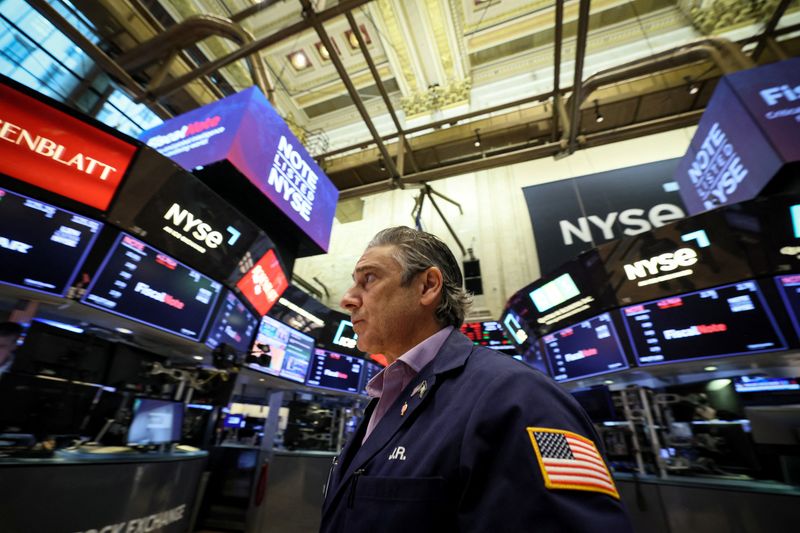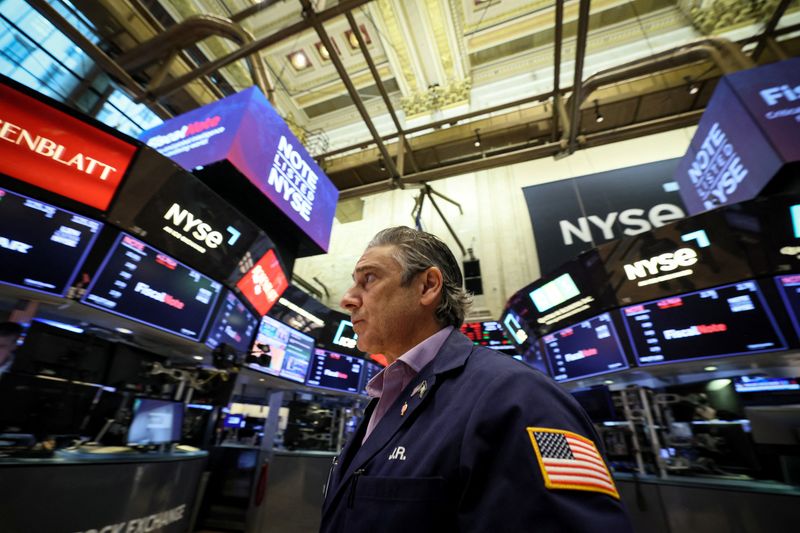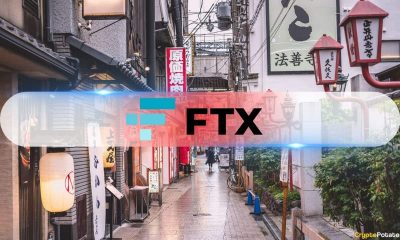Economy
Wall St rises as megacaps gain, yields slip ahead of key inflation data


© Reuters. FILE PHOTO: Traders work on the floor of the New York Stock Exchange (NYSE) in New York City, U.S., August 15, 2023. REUTERS/Brendan McDermid
By Shristi Achar A and Amruta Khandekar
(Reuters) -Wall Street’s main indexes rose on Friday as megacaps including Apple (NASDAQ:) and Microsoft (NASDAQ:) gained ahead of a fresh inflation reading next week that will provide further clues on the U.S. interest rate trajectory.
U.S. Treasury yields edged lower on Friday, helping boost major growth stocks, with Microsoft leading gains, up 1.9%, and Meta Platforms (NASDAQ:) advancing nearly 1%.
Shares of Apple rose 1.2% after a two-day selloff following news that Beijing had ordered its central government employees in recent weeks to stop using iPhones at workplaces.
Wall Street analysts see a small hit to Apple’s revenue this year from the curbs, with Morgan Stanley saying the worst case scenario was a 4% drop.
The information technology sector rose 0.6% while energy stocks rose 1.3% to their highest level in over seven months, tracking an uptick in crude prices. [O/R]
The S&P 500 and the Nasdaq have shed more than 1% this week on concerns the Federal Reserve could keep interest rates higher for longer following stronger-than-expected services activity data and a fall in weekly jobless claims.
The Consumer Price Index (CPI) reading for August is due on Sept. 13, while the Federal Reserve’s policy decision is scheduled for Sept. 20.
“My expectation is that the CPI print could come in higher than expected (with) the price of oil pushing higher,” said Phil Blancato, chief executive officer of Ladenburg Thalmann Asset Management.
“We have a problem where ultimately the Fed may be pushed into a corner, and while they might take a pause because of the lag effect, I don’t think they’re done.”
Traders’ odds for interest rates staying at current levels in September stood at 95%, while they have priced in a near 55% chance for a pause in rate hikes in the November meeting, according to CME FedWatch Tool.
Mixed comments from Fed officials have also added to uncertainty about the central bank’s next policy moves.
New York Fed President John Williams kept his options open over future interest rate path while Dallas Fed President Lorie Logan said though it “could be appropriate” to skip a rate hike in the upcoming meeting, more policy tightening might be needed.
At 11:47 a.m. ET, the was up 101.13 points, or 0.29%, at 34,601.86, the S&P 500 was up 16.12 points, or 0.36%, at 4,467.26, and the was up 65.25 points, or 0.47%, at 13,814.08.
Among other stocks, Kroger (NYSE:) rose 3.2% after the retailer beat estimates for quarterly adjusted profit.
Gilead Sciences (NASDAQ:) added 3.1% after BofA Securities upgraded the drugmaker to “buy” from “neutral.”
GameStop (NYSE:) fell 6.6% on a report that the U.S. Securities and Exchange Commission was investigating the videogame retailer’s chairman, Ryan Cohen.
Advancing issues outnumbered decliners by a 1.64-to-1 ratio on the NYSE and by a 1.01-to-1 ratio on the Nasdaq.
The S&P 500 recorded 13 new 52-week highs and 14 new lows, while the Nasdaq posted 31 new highs and 160 new lows.
Economy
Russian central bank says it needs months to make sure CPI falling before rate cuts -RBC


© Reuters. Russian Central Bank Governor Elvira Nabiullina attends a news conference in Moscow, Russia June 14, 2019. REUTERS/Shamil Zhumatov/File Photo
MOSCOW (Reuters) – Russia’s central bank will need two to three months to make sure that inflation is steadily declining before taking any decision on interest rate cuts, the bank’s governor Elvira Nabiullina told RBC media on Sunday.
The central bank raised its key interest rate by 100 basis points to 16% earlier in December, hiking for the fifth consecutive meeting in response to stubborn inflation, and suggested that its tightening cycle was nearly over.
Nabiullina said it was not yet clear when exactly the regulator would start cutting rates, however.
“We really need to make sure that inflation is steadily decreasing, that these are not one-off factors that can affect the rate of price growth in a particular month,” she said.
Nabiullina said the bank was taking into account a wide range of indicators but primarily those that “characterize the stability of inflation”.
“This will take two or three months or more – it depends on how much the wide range of indicators that characterize sustainable inflation declines,” she said.
The bank will next convene to set its benchmark rate on Feb. 16.
The governor also said the bank should have started monetary policy tightening earlier than in July, when it embarked on the rate-hiking cycle.
Economy
China identifies second set of projects in $140 billion spending plan


© Reuters. FILE PHOTO: Workers walk past an under-construction area with completed office towers in the background, in Shenzhen’s Qianhai new district, Guangdong province, China August 25, 2023. REUTERS/David Kirton/File Photo
SHANGHAI (Reuters) – China’s top planning body said on Saturday it had identified a second batch of public investment projects, including flood control and disaster relief programmes, under a bond issuance and investment plan announced in October to boost the economy.
With the latest tranche, China has now earmarked more than 800 billion yuan of its 1 trillion yuan ($140 billion) in additional government bond issuance in the fourth quarter, as it focuses on fiscal steps to shore up the flagging economy.
The National Development and Reform Commission (NDRC) said in a statement on Saturday it had identified 9,600 projects with planned investment of more than 560 billion yuan.
China’s economy, the world’s second largest, is struggling to regain its footing post-COVID-19 as policymakers grapple with tepid consumer demand, weak exports, falling foreign investment and a deepening real estate crisis.
The 1 trillion yuan in additional bond issuance will widen China’s 2023 budget deficit ratio to around 3.8 percent from 3 percent, the state-run Xinhua news agency has said.
“Construction of the projects will improve China’s flood control system, emergency response mechanism and disaster relief capabilities, and better protect people’s lives and property, so it is very significant,” the NDRC said.
The agency said it will coordinate with other government bodies to make sure that funds are allocated speedily for investment and that high standards of quality are maintained in project construction.
($1 = 7.1315 renminbi)
Economy
Russian central bank says it needs months to make sure CPI falling before rate cuts -RBC


© Reuters. Russian Central Bank Governor Elvira Nabiullina attends a news conference in Moscow, Russia June 14, 2019. REUTERS/Shamil Zhumatov/File Photo
MOSCOW (Reuters) – Russia’s central bank will need two to three months to make sure that inflation is steadily declining before taking any decision on interest rate cuts, the bank’s governor Elvira Nabiullina told RBC media on Sunday.
The central bank raised its key interest rate by 100 basis points to 16% earlier in December, hiking for the fifth consecutive meeting in response to stubborn inflation, and suggested that its tightening cycle was nearly over.
Nabiullina said it was not yet clear when exactly the regulator would start cutting rates, however.
“We really need to make sure that inflation is steadily decreasing, that these are not one-off factors that can affect the rate of price growth in a particular month,” she said.
Nabiullina said the bank was taking into account a wide range of indicators but primarily those that “characterize the stability of inflation”.
“This will take two or three months or more – it depends on how much the wide range of indicators that characterize sustainable inflation declines,” she said.
The bank will next convene to set its benchmark rate on Feb. 16.
The governor also said the bank should have started monetary policy tightening earlier than in July, when it embarked on the rate-hiking cycle.

 Forex2 years ago
Forex2 years agoForex Today: the dollar is gaining strength amid gloomy sentiment at the start of the Fed’s week

 Forex2 years ago
Forex2 years agoHow is the Australian dollar doing today?

 Forex2 years ago
Forex2 years agoUnbiased review of Pocket Option broker

 Forex2 years ago
Forex2 years agoDollar to pound sterling exchange rate today: Pound plummeted to its lowest since 1985

 Cryptocurrency2 years ago
Cryptocurrency2 years agoWhat happened in the crypto market – current events today

 World2 years ago
World2 years agoWhy are modern video games an art form?

 Stock Markets2 years ago
Stock Markets2 years agoMorgan Stanley: bear market rally to continue

 Economy2 years ago
Economy2 years agoCrude oil tankers double in price due to EU anti-Russian sanctions

































